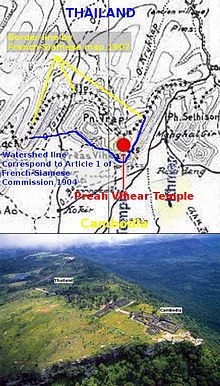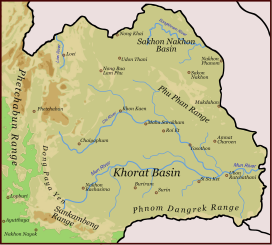
Sisaket province is one of Thailand's seventy-six provinces (changwat). It lies in lower northeastern Thailand, a region called Isan. Neighboring provinces are : Surin, Roi Et, Yasothon, and Ubon Ratchathani. To the south it borders Oddar Meancheay and Preah Vihear of Cambodia.
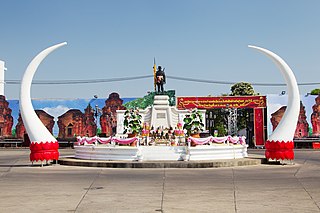
Surin is one of Thailand's seventy-seven provinces (changwat). It lies in lower northeastern Thailand, also called Isan. Neighboring provinces are Buriram, Maha Sarakham, Roi Et, and Sisaket. To the south it borders Oddar Meancheay of Cambodia. Surin covers a total area of 8,124 km2 (3,137 sq mi) from the Mun River in the north to the Dangrek Mountains in the south. The capital, Surin city, in the western central region province is 434 km from Bangkok.
Articles related to Cambodia and Cambodian culture include:
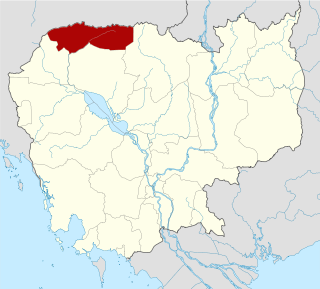
Oddar Meanchey is a province of Cambodia in the remote northwest. It borders the provinces of Banteay Meanchey to the west, Siem Reap to the south and Preah Vihear to the east. Its long northern boundary demarcates part of Cambodia's international border with Thailand. The capital is Samraong.

Preah Vihear is a province (khaet) of Cambodia. It borders the provinces of Oddar Meanchey and Siem Reap to the west, Kampong Thom to the south and Stung Treng to the east. Its northern boundary forms part of Cambodia's international border with Thailand and Laos. Its capital is Preah Vihear.

The Phu Phan mountains are a range of hills dividing the Khorat Plateau of the Isan region of Thailand into two basins: the northern Sakhon Nakhon Basin, and the southern Khorat Basin.

Preah Vihear Temple is an ancient Hindu temple built by the Khmer Empire, located on top of a 525-metre (1,722 ft) cliff in the Dângrêk Mountains, in the Preah Vihear province of Cambodia.

Nam Yuen is the southernmost district (amphoe) of Ubon Ratchathani province, northeastern Thailand.
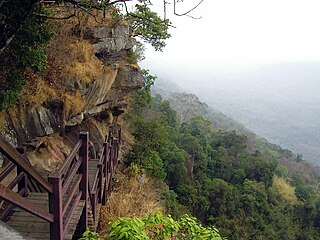
Khao Phra Wihan National Park is a protected natural area in Sisaket Province, Thailand, that contains numerous ruins of the 11th century Khmer Empire. The park lies 98 km (61 mi) south of the town of Sisaket, at the end of Thai highway 221. Sited on a red stone cliff that is part of the Dangrek mountain range on the southern edge of the Khorat Plateau, it abuts the international border between Thailand's Sisaket Province and Cambodia's Preah Vihear Province. The name of the cliff in the Royal Thai General System of Transcription is Pha Mo I Daeng (ผามออีแดง). The park was established on 20 March 1998, with an area of 81,250 rai ~ 130 square kilometres (50 sq mi).
Anlong Veng is a district (srok) in Oddar Meanchey province in Cambodia. The main town in the district is also called Anlong Veng. The population of the district could not be counted during the 1998 census of Cambodia due to ongoing conflict during the time of the census. It is estimated that 35% of the population in Anlong Veng were former Khmer Rouge soldiers including the Maoist dictator Pol Pot.

The Cambodian–Thai border dispute began in June 2008 as part of a century-long dispute between Cambodia and Thailand involving the area surrounding the 11th-century Preah Vihear Temple, in the Dângrêk Mountains between Choam Khsant District, Preah Vihear Province of northern Cambodia and the Kantharalak District, Sisaket Province of northeastern Thailand.

The Sankamphaeng Range, also Sankambeng Range or Sungumpang Range is one of the mountain ranges separating eastern Thailand from the northeast or Isan. It is in Nakhon Nayok, Prachinburi, Sa Kaeo, Saraburi, and Nakhon Ratchasima Provinces, Thailand.

Bilateral relations between Cambodia and Thailand date to the 13th century during the Angkor Era. The Thai Ayutthaya Kingdom gradually displaced the declining Khmer Empire from the 14th century, French protectorateship separated Cambodia from modern Thailand at the turn of the 19th–20th centuries, and diplomatic relations between the modern states were established on 19 December 1950.
O Smach, also spelled O'Smach or Ou Smach, is a small Cambodian town on the Thai border in Samraong Municipality of Oddar Meanchey Province. Until 1999, there were intermittent battles, and the area was unsafe as the last remaining Khmer Rouge still had control of nearby Anlong Veng. In 2003, an international border crossing was opened between O Smach and the adjacent town of Chong Chom in Thailand's Surin Province. There has since opened a strip of casinos between the Cambodian and Thai passport control counters, enabling Thais to gamble in Cambodia without needing to go through Cambodian immigration. Gambling is illegal in Thailand and gambling in Cambodia is legal only for foreign passport holders. O Smach is at the northern terminus of Road 68 which turns north off National Highway 6 at Kravanh in Siem Reap Province.

Prasat Ta Muen Thom or Prasat Ta Moan Thom is a Khmer temple located on Cambodian-Thai border.
Prasat Ta Krabey or Prasat Ta Krabei, in Khmer and also known as Prasat Ta Khwai, in Thai, is a disputed Khmer temple which was built during Angkor period, the golden age of Cambodian history. This 11th century religious site was constructed in order to be dedicated to Hindu god Shiva and has become a tourist attraction site near Cambodian-Thai border in recent years.

The Cambodia–Thailand border is the international border between Cambodia and Thailand. The border is 817 km (508 mi) in length and runs from the tripoint with Laos in the north-east to the Gulf of Thailand in the south.
Phrai Phatthana is a tambon (subdistrict) of Phu Sing District, Sisaket Province, lower northeastern Thailand.

The Dangrek genocide, also known as the Preah Vihear pushback, is a border incident which took place along the Dangrek Mountain Range on the Thai-Cambodian border which resulted in the death of many mostly Sino-Khmer refugees who were refused asylum by the Kingdom of Thailand in June 1979.



